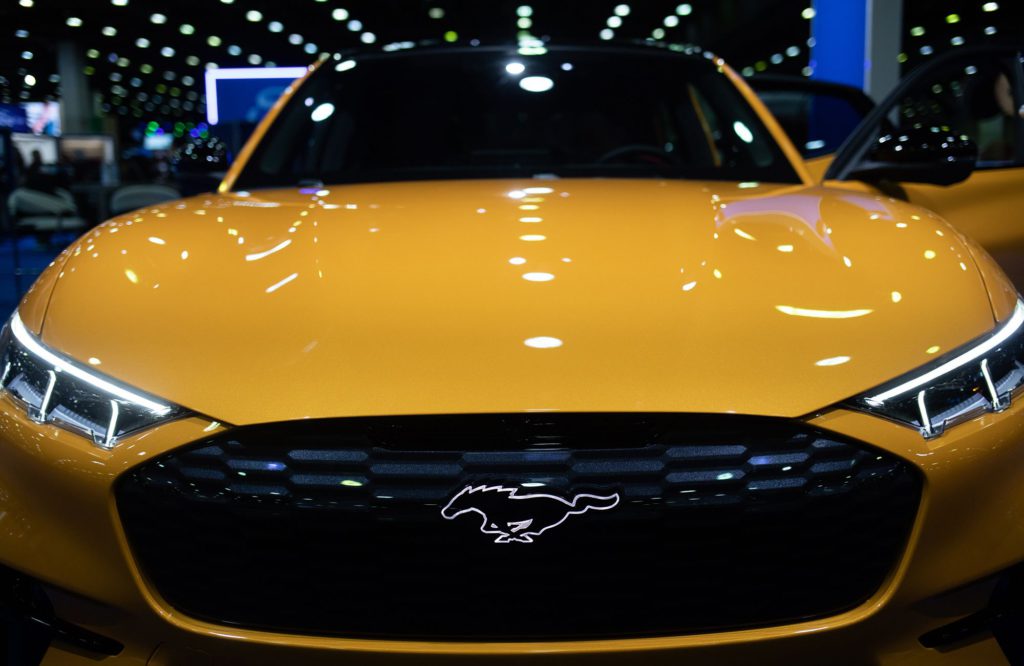Ford Motor Co. is slashing the price of its electric Mustang Mach-E by an average of $4,500 in response to Tesla Inc.’s own recent cuts, stepping up the price wars in a slowing EV market.
(Bloomberg) — Ford Motor Co. is slashing the price of its electric Mustang Mach-E by an average of $4,500 in response to Tesla Inc.’s own recent cuts, stepping up the price wars in a slowing EV market.
The discount comes on a model that Ford has already described as unprofitable, but the automaker said it hopes to offset further margin deterioration by boosting production 67% this year.
The move, along with discounted financing rates as low as 5.3% on the Mach-E, is meant to counter Tesla’s decision to cut prices across its lineup by as much as 20%. It also brings the Mach-E in line with new caps on EV prices to qualify for federal tax credits of up to $7,500 under the Inflation Reduction Act. The fight to win over buyers comes as analysts predict the pace of growth for EVs will slow this year.
“Our competitors are also adjusting their prices,” Marin Gjaja, chief customer officer for Model e, Ford’s EV unit, told reporters. “As we look and want to stay competitive in the marketplace, we’re having to respond.”
Ford’s shares pared a dip as low as 2.4% to trade down 1.4% to $13.08 as of 11:19 a.m. in New York. Investors are bracing for a price war as other EV makers are likely to follow suit to keep their vehicles competitive.
“We expect more price cuts to come,” Tom Narayan, an analyst with RBC Capital Markets, wrote in a note to investors Monday. “The Tesla cuts in our view will and have started to create a cascading effect.”
The lowest priced Mach-E now starts at $45,995, down $900, while the most expensive GT Extended Range version falls $5,900 to start at $63,995. The California Route 1 extended range version, meanwhile, is marked down almost 9% to start at $57,995.
Chief Financial Officer John Lawler said in June that profits on the Mach-E had been “wiped out” by rising commodity costs. The automaker responded then by raising prices on the Mach-E to reduce losses, Lawler said.
“You’re going to see pressure on the bottom line when we launch our EVs, they’re not going to be positive,” Lawler said at the Deutsche Bank automotive conference.
Gjaja said Ford is working to improve margins on the Mach-E, but wouldn’t say if the model has become profitable.
“We absolutely want to make money,” Gjaja said. “We are re-engineering the vehicle on a perpetual basis to try to get cost out.”
The Mach-E’s business case also will improve by boosting production this year to 130,000 models from 78,000 last year, Gjaja said. The Mach-E factory in Cuautitlan, Mexico, is idled currently as the automaker retools it to expand capacity. It will come back online in February, Gjaja said.
“We’re seeing real improvements in our cost position as a result of scaling up our production and we’re seeing some relief on some commodities,” Gjaja said.
Ford is investing $50 billion to develop and build electric vehicles and plans to produce 2 million a year by the end of 2026. The Dearborn, Michigan-based automaker was the No. 2 seller of EVs in the US last year, well behind Tesla, which controls almost two-thirds of the market.
With a gross automotive margin of 25.9% in the fourth quarter, Tesla can cut prices while still generating healthy profits. Ford lacks that breathing room, analysts say.
“Tesla has higher margins than other OEMs including GM and Ford, and cushion to lower prices even further,” John Murphy, a Bank of America analyst, said earlier this month. “Most OEMS are currently losing money on EVs, and these price cuts are likely to make business even more difficult, just as they are attempting to ramp production of EV offerings.”
(Updates with analyst comment in sixth paragraph.)
More stories like this are available on bloomberg.com
©2023 Bloomberg L.P.










